

Most municipalities permit homeowners or do-it-yourself enthusiasts to install a PV rooftop solar system; often a simple inspection and approval by a qualified electrician or certified solar installer will be all you need.
They’re fast to install. Usually an installation can be completed in a week—even by a DIYer—after all the required equipment and materials are on site. Energy independence is an advantage that has strong appeal for many homeowners, and PV solar systems can reduce vulnerability to power loss from grid blackouts or power outages. You should see immediate savings on your electric bills and begin recovering your investment right away.
PV solar systems are also flexible; you can start small and add more PV panels later on. With solar rooftop systems, everything is modular.
Leasing is available in most areas. If you have limited cash flow, this option can provide an easy way to get a PV solar system installed on your rooftop. It’s also easy to obtain financing, if required; most US banks have ample experience financing solar PV rooftop systems. In addition, government cash rebates, tax exemptions, and other financial incentives are often available, and these can substantially reduce the cash investment you need to make. PV systems have a relatively short payback period that can be as short as six or seven years—or even less, with rebates and other government incentives.
Your solar panel system should have a long and useful life. A warranty of 25 years from module manufacturers is standard. Systems can be installed on both flat and sloped roofs, and even on vertical surfaces. They provide myriad long-term environmental benefits and require almost zero maintenance.
Lastly, they immediately increase the value of your home, often by more than the cost of the PV solar system itself.
This is a formidable list of advantages to installing a PV solar system in your home. The only “negative” factor is the substantial investment or capital cost of the PV system, but this is generally more than offset by the advantages, financial and otherwise. The guidelines in this book will make it easy for you to calculate the financial and economic aspects of whichever PV solar system you choose for your home. I’ll also help you perform a simple cost-benefit analysis of your project or proposed PV system. Reading this book will put you in control.
• Monocrystalline silicon panels
• Polycrystalline silicon panels
• Thin-film technology (in panels or other formats)
The best-known and most common of these is the polycrystalline silicon panel, and the third type, “thin film,” has up to four different versions, meaning that there are actually up to six kinds of PV technology to choose from. This might seem confusing at first, but this book will make it easy for you to determine which PV technology type is best for your particular needs.
Here are a few more photographs that illustrate the versatility of solar panel applications and installations.
This book will help you understand the various PV solar technologies and enable you to choose the most advantageous system for your home and budget. It will also give you valuable tips on how to choose a contractor, if this is the route you decide to take. It will show you how to calculate the electric power you can produce using any given system and how much money your chosen system can save on your monthly electric bills.
In Chapter 1, I will outline the main features, advantages, and disadvantages of each available technology type so that you can choose from the diverse range of options and components.
In Chapter 2, I will discuss and illustrate three different options for connecting or not connecting to the electric utility grid: “grid-tied,” “off-grid,” and “hybrid.”
In Chapter 3, I will illustrate and summarize all the major components of a PV solar rooftop system.
In Chapter 4, I will show you how to determine the optimum size of your proposed PV solar rooftop system.
In Chapter 5, I will explain how to calculate the annual energy output of any given PV solar rooftop system, and I’ll give you two simple ways to calculate the optimum number of solar panels needed to produce the amount of energy you will require under your particular set of circumstances and in your specific location. Chapter 5 will also show you an easy way to calculate how much money your PV solar system can save you compared to your existing monthly utility bills over a 12-month period.
In this photo, we can see the solar PV system is being installed at the same time as the installation of a new roof.
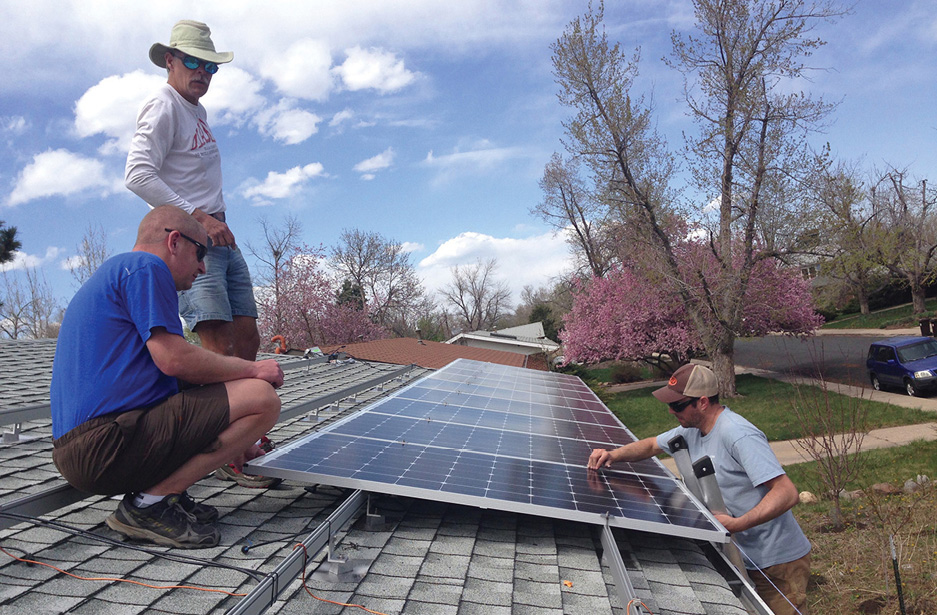
Here, we can see a do-it-yourself crew of three installing mono panels on the aluminum rails of an array that aligns very close to the edge of the roof just above the eaves trough.
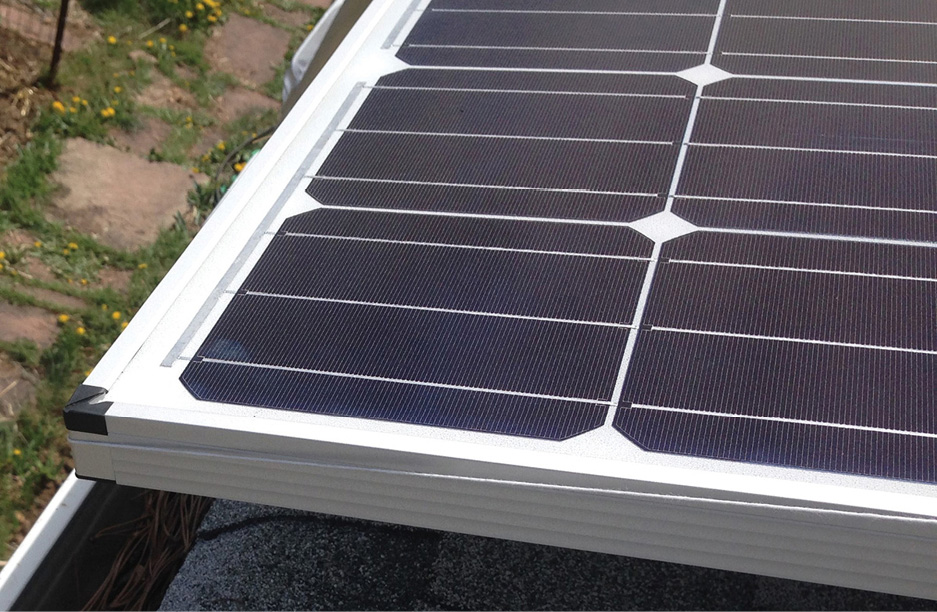
A close-up shot of the corner of a mono panel at the end of an array.
Here we see the installer tightening a mid-bracket between two poly panels and securing them to the railings of the support framework.
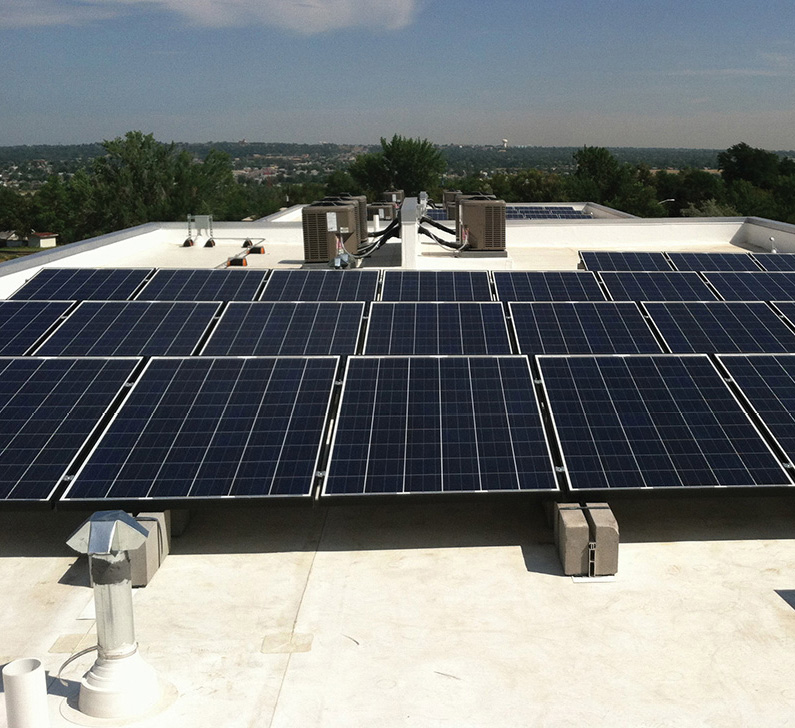
Numerous solar arrays with over 50 panels mounted on a flat condo rooftop with a tilt of about 20 degrees indicating that this installation is in a location with a latitude of about 20 degrees.
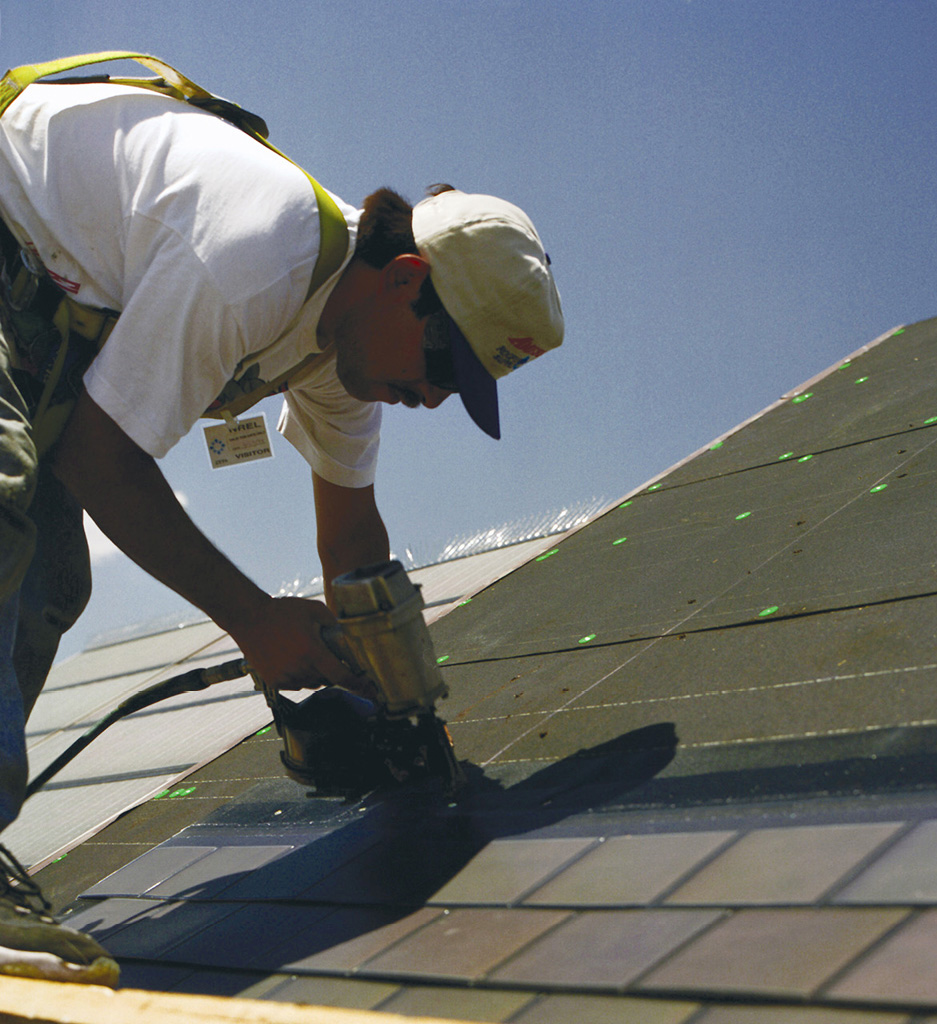
The installer is securing this thin film array onto a very steep roof flush with the roof surface.
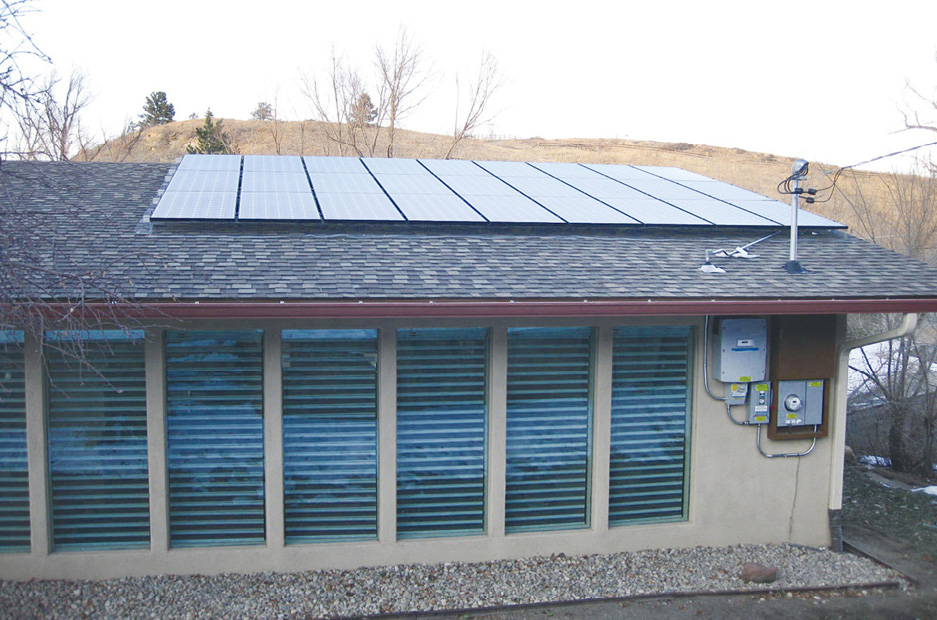
A low-level rancher with an array of 11 panels mounted flush to the roof surface.
In Chapters 4 and 5, you will also learn to calculate how long it will take to recover your initial investment—normally only six or seven years, depending on the amount of solar irradiance available throughout the year at your location, and depending on government subsidies, rebates, and other incentives you may qualify for, as explained in Chapter 6.
In Chapter 7, I will summarize the environmental benefits of residential and commercial PV solar systems and show you how to calculate the annual amount of CO2 emissions that can be prevented from entering the atmosphere with any solar PV system.
In Chapter 8, you will learn many useful and effective measures and complementary mini-projects that will maximize the benefits to be gained with a solar PV project for your home. These measures should not only save you money in the long run, they will also reduce the required size and cost of the solar PV system needed to power 100 percent of your home’s requirements. Lots of good ideas here!
In Chapter 9, I will show you how to find a qualified and registered solar installer in your area—or even a DIY coach, who can help you to save money by doing the installation yourself.
In Chapter 10, I will include a detailed, step-by-step photographic procedure on how to install a complete PV solar rooftop system.
In Chapter 11, I will summarize the main conclusions from previous chapters and, using this book as a guide, provide you with some helpful basic recommendations on how you might best proceed with plans to execute your PV solar project.
This is your handbook to planning your own PV solar rooftop system. I’ll help you develop a customized action plan for a successful project that will benefit you and your family for decades to come. Photovoltaics, or PV technology, continue to be used in different ways and in new devices all the time: for powering parking-lot and highway lighting; for schools in remote villages with no access to the utility grid; for residential, commercial, and industrial applications; for electric vehicle charging stations; for remote microwave transmission stations; and even for boats, small power tools, and other devices.
Predictions of a solar revolution become more common with every passing year, and in some countries it’s already becoming a reality. In Germany, for example, PV solar–installed capacity in 2012 increased by 7.6 Gigawatts to a total of over 35 Gigawatts by late 2013. This represents approximately 3.5 percent of the nation’s electricity production. Some market analysts believe this figure could reach 25 percent by 2050. But the government has even higher goals than those predicted by market analysts. Germany announced an official goal of producing 35 percent of electricity from renewable sources by 2020—and 100 percent by 2050! These are formidable national goals, and some would say they are overly optimistic. But the trend is definitely upward around the world.
This phenomenon has been created in large part due to feed-in tariff (or FiT) schemes. These government financial incentive programs—in Germany and in other countries worldwide—have for decades provided subsidies to homeowners in order to encourage and stimulate the growth of the PV solar energy infrastructure.
Other countries that have been following Germany’s lead in developing PV solar energy as an important renewable power source include England, the USA, India, Spain, Italy, Australia, France, Canada, Japan, and numerous countries in Southeast Asia. The expansion of the PV solar energy industry has short-and long-term environmental benefits, but there are more powerful economic and political factors behind the growing universal government support for solar energy. The political element usually involves developing solar power in order to decrease future dependency on carbon-based fuel imports, such as diesel and liquefied natural gas (LNG), and to reduce national expenditures on these imports. The goal is to achieve independence from foreign control over energy supplies.
Two important long-term economic trends have also provided incentives for more solar. These trends include, on the one hand, the year-by-year reduction in manufacturing costs and the market price index for PV solar panels, and on the other hand, the increasing annual cost of electricity produced by the national-grid utility companies that use carbon-based fuels, a finite natural resource. Crude-oil prices on the world market go up or down in any given year, but the five-year average trend has generally been upward over the long term. Between 2015 and ’16, it is well known that there was a huge drop in crude oil prices on the world market and this was reflected, to some degree, by decreases in gasoline and fuel oil prices in most countries. However, this did not affect in any major way the cost of electricity to homeowners because the utility’s electricity rates to the public are not so directly tied to global crude oil prices, being that the amortized annual cost of the capital equipment used in oil burning generating stations is proportionately so much greater than the cost of the crude oil consumed in these gigantic plants. In any case, the utilities are reluctant or very slow to pass on any savings to a significant degree. Utility rates may decrease slightly for a while but they can be expected to continue to increase over the long term. The net result is that global crude oil prices are of limited consequence to the solar PV residential market.
These two trends will eventually lead to what is known as “grid parity,” the point at which the cost of PV solar power to the consumer or end user is equal to the cost of electricity from the national electric grid, usually measured in terms of a cost figure per kilo-watt hour, i.e.: “$/kWh” in North America or “€/kWh” in Europe. Grid power in Europe has traditionally been much more expensive than in North America.
An array of nine large mono panels installed parallel to a rooftop has a very minor slant of about 15 degrees, indicating that this location is likely near 15 degrees latitude, probably in the southern United States.
Two DIY installers start to install a large number of poly panels on a low-tilt roof of white asphalt tiles. You will notice that the aluminum rails of the solar system support structure have already been completed without any additional tilt.
Four arrays of five poly modules, each installed with two arrays on the main house and two equal-size arrays on the garage. We can see that the roof has a tilt of about 30 degrees and the arrays are mounted with an additional tilt of about 15 degrees for a total tilt of about 45 degrees, indicating that this house is likely located near the 45th degree of latitude to face the sun at 90 degrees for maximum energy output. This is explained in detail in Chapter 5.

Three arrays of 12 poly modules, each that are ground-mounted on three terraces in steep terrain. When your rooftop space is insufficient for your solar power requirements, this type of ground-mounted supplementary PV installation may be a good solution if the extra space is available somewhere behind your house.
In many countries, grid parity has already become a reality and the trends leading to grid parity are generally considered to be irreversible. In countries where conventional electric energy from carbon-based power plants is still relatively cheap, the incentive to install solar is usually less than in countries closer to grid parity, but these trends are present worldwide.
These political and economic factors are further reinforced by the environmental benefits of using PV solar. Photovoltaics are a totally clean source of electric energy, a stark contrast to conventional energy sources that burn highly toxic carbon-based fuels (diesel oil, coal, or liquid natural gas) to power large electric generators in big buildings characterized by tall, wide-diameter chimneys. During combustion, these conventional carbon-based fuels emit large amounts of carbon dioxide—or CO2—that are released into the atmosphere and contribute directly to the greenhouse effect that causes global warming. These CO2 gas emissions are quantified in terms of tons of CO2. In Chapter 7, I’ll show you how to calculate the savings in CO2 emissions you can achieve with any PV solar rooftop system for any given time period.
Accurate statistics are available that show how much conventional carbon-based fuel is consumed in the production of a given amount of electricity, measured in kWh. Statistics are easily calculated as to how many tons of CO2 are emitted by carbon-based fuels while generating electricity, i.e.: for every MWh (1,000 kWh) of power. Therefore, if we know the amount of power produced by a PV solar system in kilowatt hours or megawatt hours, we can calculate exactly how many tons of CO2 gas emissions are prevented from entering the atmosphere by virtue of using renewable photovoltaic energy instead of conventional carbon-based fuels.
Of all electricity-producing plants, coal-fired generators produce the highest level of CO2 emissions. Solar PV farms and rooftop PV solar systems produce zero CO2. The ability to precisely measure CO2 emissions enables regulatory bodies such as the United Nations (UN) to establish international treaties and national limits for CO2 emissions. This has led to an international system of carbon credits, which enables us to determine how much CO2 (in tons) a given PV system prevents from entering the atmosphere.